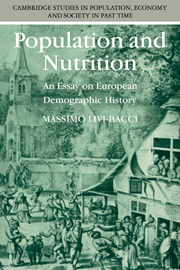Book contents
- Frontmatter
- Contents
- List of figures
- List of tables
- Preface
- 1 Demographic growth in Europe
- 2 Energy, nutrition and survival
- 3 Famine and want
- 4 The starving and the well-fed
- 5 Food and standard of living: hypotheses and controversies
- 6 Antagonism and adaptation
- Notes
- General index
- Cambridge Studies in Population, Economy and Society in Past Time
5 - Food and standard of living: hypotheses and controversies
Published online by Cambridge University Press: 20 October 2009
- Frontmatter
- Contents
- List of figures
- List of tables
- Preface
- 1 Demographic growth in Europe
- 2 Energy, nutrition and survival
- 3 Famine and want
- 4 The starving and the well-fed
- 5 Food and standard of living: hypotheses and controversies
- 6 Antagonism and adaptation
- Notes
- General index
- Cambridge Studies in Population, Economy and Society in Past Time
Summary
Soundings in a vast sea
Up to this point we have dealt with various controversial aspects of the relationship between nutrition, health and mortality. It is time now to address a question which has thus far remained in the background: What can we say about long-term dietary trends in European societies? Did these historical populations fight a ceaseless battle against the scarcity of resources; or did they on the whole live well above the threshold of malnutrition; or might they have fluctuated over long periods between comfortable plenty and dire hardship? And supposing these trends can be ascertained, how do they fit in with mortality trends?
It is important to state at the outset that a satisfactory account of Europe's nutritional history does not exist. Agricultural history, though abounding in comprehensive studies on cultivation techniques and yield, land management and price trends, is very uninformative when it comes to the estimation of production flows which would enable estimation of consumption levels. Nevertheless, a few soundings have been made which enable the measurement of longterm changes in nutritional patterns and it is to these that we shall refer in this chapter. These soundings take the form of estimates of food budgets in a number of communities and their assumed caloric content; levels of consumption for some staples like bread or meat; the spread and contribution to diets of new crops such as maize and potatoes; comparisons of wage and price trends for the main foodstuffs (mainly cereals) as indicators of the purchasing power and the standard of living of certain classes of the population; and variations in stature as a ‘net’ indicator of the community's level of nutrition.
- Type
- Chapter
- Information
- Population and NutritionAn Essay on European Demographic History, pp. 79 - 110Publisher: Cambridge University PressPrint publication year: 1991

